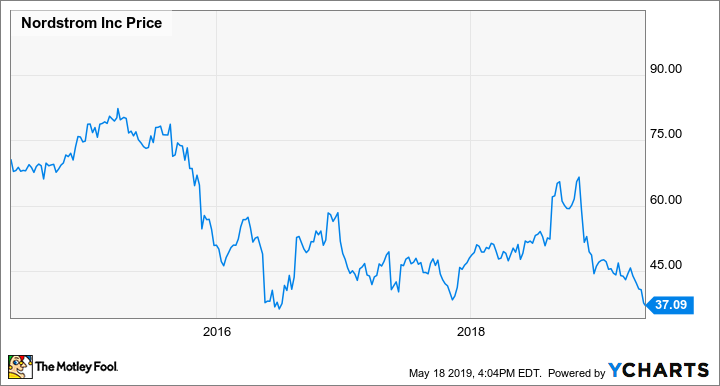Nordstrom (JWN -2.81%) showed strong signs of progress last year, following a string of weak years. Indeed, the upscale retailer achieved a 2.4% comparable sales increase in the first nine months of fiscal 2018, including solid growth in both its full-price and off-price segments.
However, as with a number of other retailers, Nordstrom's performance deteriorated toward the end of the year. Comparable sales rose just 0.1% in the fourth quarter with a 1.6% decline in the full-price business almost fully offsetting a 4% increase in off-price comps. Predictably, this growth slowdown caused Nordstrom stock to tank, leaving it near a multiyear low as of this writing.
Data by YCharts.
Investors are nervously awaiting the company's first-quarter earnings report, which will come out after the market close on May 21. Here are the key things to watch.
Expect similar trends to the fourth quarter
Early in the quarter, Nordstrom executives warned investors not to expect a quick rebound in performance. Nordstrom's guidance calls for 1% to 2% sales growth in fiscal 2019, but as of late February, management expected growth to be below that range in the first quarter. Sales trends should improve over the course of the year, though, lifted by the popular Nordstrom Anniversary Sale over the summer and the opening of Nordstrom's Manhattan flagship store -- and two associated Nordstrom Local service hubs -- this fall.
Nordstrom also projected that operating profit would decline in the first quarter, compared to the $153 million it earned in the year-ago period. That's due in part to Nordstrom's expected slow sales growth during the period. Additionally, while the company ended 2018 with inventory down year over year, it still had "pockets of excess inventory" and planned to take markdowns last quarter to clear out aging inventory.
Based on this muted outlook, analysts are calling for sales to edge up 0.4% to $3.57 billion and for earnings per share to fall to $0.43 from $0.51 a year ago.

Nordstrom is likely to post weak sales and earnings results for the first quarter. Image source: Nordstrom.
Checking in on stock buybacks
The upside of the late-2018 sales slowdown (and corresponding stock swoon) for Nordstrom shareholders is that it created an excellent opportunity for the company to shrink its share count. Under a five-year capital allocation plan presented last July, Nordstrom said that it intends to spend about $3.7 billion on share repurchases between fiscal 2018 and fiscal 2022.
For a variety of reasons, Nordstrom spent just $155 million on buybacks in the first three quarters of last year. That wasn't even enough to fully offset the shares issued under Nordstrom's stock-based compensation plans. By contrast, the company spent more than $500 million to repurchase upwards of 11 million shares in the fourth quarter, when the share price had already declined significantly.
With Nordstrom stock having fallen further in recent months, the company likely continued to return cash to shareholders at an aggressive pace last quarter. Indeed, as of March 15 -- midway through the quarter -- Nordstrom had 155 million outstanding shares, down from 157.6 million at the beginning of the period.
By shrinking its share count today, while the stock sits near a multiyear low, Nordstrom could be setting the table for explosive EPS growth over the next few years, assuming the company is able to meet its targets for revenue growth and margin improvement.
The outlook is the key
Nordstrom executives signaled months ago that the first quarter would probably be challenging, so the company's recent sales trends and its guidance for the second quarter and beyond may matter more to investors than the reported numbers. If Nordstrom indicates that sales improved over the course of last quarter and maintains or raises its full-year guidance, then Nordstrom stock could leap higher following the earnings report. By contrast, if the company slashes its full-year outlook, the stock will likely sag further.
That said, investors should look beyond the earnings-related market reaction. Nordstrom is nearing the end of a multiyear period of heavy investments that have weighed on its earnings and free cash flow. As its investments in the new Manhattan flagship store and various omnichannel initiatives start to pay off over the next few years, the company's financial results should improve significantly.





